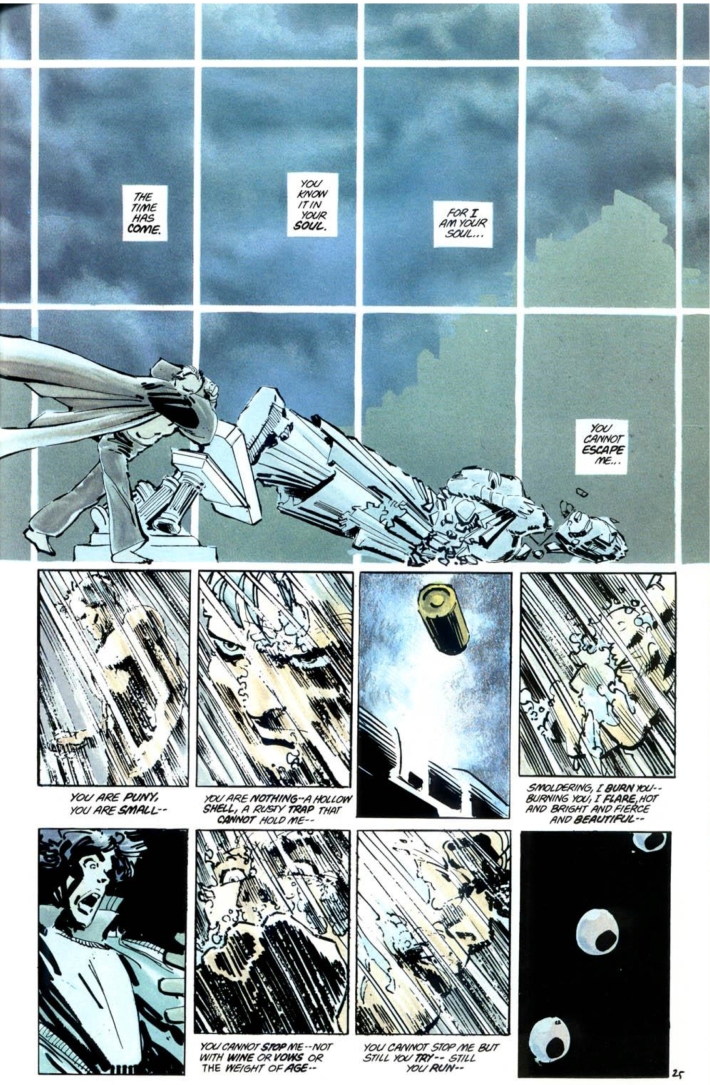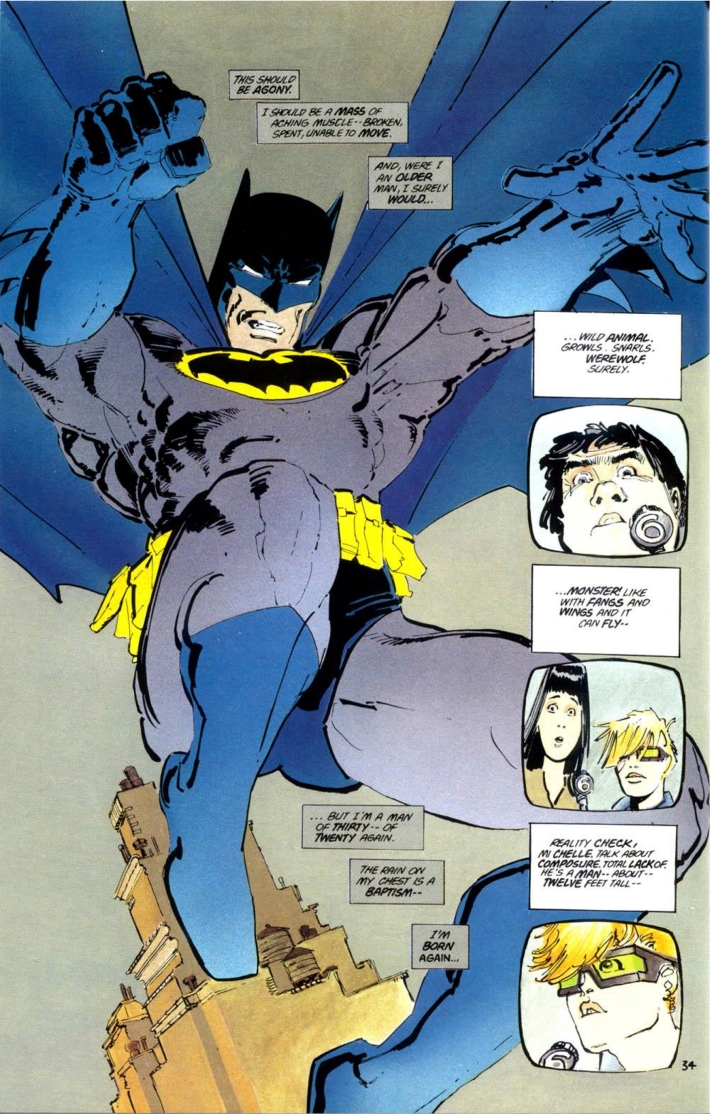Tags
analysis, arkham asylum, batman, batman begins, bruce wayne, christian bale, comics, critical analysis, english, film studies, frank miller, gotham, graphic novel, graphic novels, media studies, mutants, pictures, re-envisioning, reading, review, superheroes, the dark knight, the dark knight returns, the dark knight rises, the joker, theory, thoughts, two-face
Foreword: As promised, I am dedicating this post to discussing how Frank Miller re-envisioned the character of Batman in “The Dark Knight Returns.” With that said, I have decided to move away from the more general/overview model of my last post, and venture back to a close reading/textual analysis model that I used in an earlier one.
Background Info: In the original story of Batman, Bruce Wayne was a playboy millionaire who disguised himself as Batman when he donned a costume and fought crime. In other words, Batman is just a character that Bruce Wayne plays to strike fear into the hearts of the criminals that he attacks, as well as to hide his identity from the public. In “The Dark Knight Returns,” Frank Miller turns the original story on its head by shifting the central focus from Bruce Wayne to Batman, and by portraying these two characters as radically different entities— both physically and mentally—that inhabit the same body.
Analysis: In the beginning of “The Dark Knight Returns,” the reader learns that Batman has not been spotted in ten years, and that the citizens of Gotham suspect that he is either dead or retired. The reader soon discovers that Bruce Wayne has been deliberately repressing Batman for the last ten years, ever since he took a vow to never let Batman take control of their shared body again. Although the voice of Batman is never directly heard at this point in the story, Bruce Wayne makes it clear that he must exercise an extraordinary amount of self-control to keep him at bay, as he explains that Batman “struggles relentlessly, [and] hatefully, to be free” (Miller 19). In fact, Bruce Wayne highlights the hardships he must endure as he explains that Batman preys on him when he is most vulnerable, by bringing him to the bat-cave “when the night is long and [his] will is weak” (Miller 19). Although faced with unimaginable temptation by Batman, Bruce Wayne stays firm and reassures himself of the control his possess as he thinks, “I will not let him [break free]. I gave my word” (Miller 19).
Although Bruce Wayne’s self-control is strong, Batman’s desire for escape is also strong. This becomes apparent to the reader about halfway through the first book of “The Dark Knight Returns,” when the voice of Batman is heard for the first time, signaling a shift in the battle for control over their shared body. Batman attempts to assert his dominance over Bruce Wayne in three separate yet intertwined ways: 1. By belittling him—Batman tells Bruce Wayne, “you are puny [and] you are small” 2. By relegating him to the position of a mere vessel—Batman tells him, “you are nothing [but] a hollow shell” 3. And by declaring his unstoppable power—Batman tells him, “you cannot stop me—not with wine or vows or the weight of age” (Miller 25).
Despite being inescapable and unstoppable, Batman still remains trapped inside the body that is currently controlled by Bruce Wayne. In fact, Frank Miller likens Batman’s captivity to that of a person trapped inside a prison cell, by visually representing his symbolic struggle throughout page twenty six. In the first panel, the windowpanes cast a shadow—that resembles prison bars—over the physically and mentally broken body—ruled by Bruce Wayne—who leans over a table for support[1]. This striking symbolism continues in the fourth panel, where the reader is shown the view from inside “the prison.” It is worth noting this perspective is much darker then the aforementioned panel, both literally, in the sense that the panel is almost entirely black and devoid of color, and metaphorically, in the sense that there seems to be no possibility of escape for Batman. However, this perspective is lightening in panel seven, both literally, in the sense that the panel itself is brighter, and metaphorically, in the sense that the flying bat offers a possibility for escape. Throughout the page, the warring perspectives of Bruce Wayne (the dark panels) and Batman (the light panels) continue in their battle for control over the single body that they share. In the end, the possibility of escape is realized in the final panel of the page in which the flying bat crashes through the window, representing the symbolic freedom that Batman has finally attained[2].
Although it is alluded to throughout the next several pages of the graphic novel as criminals are violently assaulted, and innocent civilians are saved by a mysterious force, it becomes explicitly clear on page thirty-four that Batman has indeed come out of retirement. Here, for the first time in “The Dark Knight Returns,” the massive physical differences between the characters of Batman and Bruce Wayne start to become clear—Bruce Wayne is fifty-five years old and has fallen victim to the weight of age, while Batman is a man of twenty or thirty years who is in excellent physical condition[3]. Additionally, the reader can also begin to see the vast mental differences between the two characters—Bruce Wayne is peaceful, complacent, and has a bit of a drinking problem, while Batman is violent and frequently acts impulsively[4].
[1] Here I think it is important to recognize Frank Miller’s homage to the genre of noir in his use of shadow to evoke imagery of both the prison cell and captivity. Here are some visual examples of the noir style shadow from the film Double Indemnity: http://blsciblogs.baruch.cuny.edu/eng3940h/files/2010/02/double-indemnity-legacy-series-edition-20060830022522077_640w.jpg and http://blsciblogs.baruch.cuny.edu/eng3940h/files/2010/02/CM-Capture-5.png.
[2] Here it is important to note that even though Batman is shown without his costume several times throughout the rest of the graphic novel, he is NOT Bruce Wayne; Batman and Bruce Wayne are distinguished from each other by their mental attitudes, physical abilities, and various other characteristics, not by their clothing.
[3] While this is the first example of the contrast between Batman’s physical prowess and Bruce Wayne’s physical weakness, it is certainly not the only one. In fact, I think this aforementioned difference become much more apparent during Batman’s battles with the mutant leader later on in the story.
[4] It should be noted that these examples have not been drawn from a single panel, but rather they have been gathered from various pages throughout the story, and have been synthesized here for the sake of simplicity.





As someone who has very little interest in DC titles in general, I still really appreciated your analysis and make note of Frank Miller’s genuinely creative approach to the Batman mythology.
Thank you very much for taking the time to read my analysis of “The Dark Knight Returns,” I really appreciate it! To be honest, I have just recently begun to read and appreciate comics/graphic novels in general, and I am looking for more works to explore. Are there any Marvel titles, preferably ones that can easily be obtained, that you would recommend?
Right now, one that has been peaking my interest and that is still fairly new is “All-New X-Men.” I do not follow the X-Men, and in fact, this is the first X-Men comic I have picked up. It tells the story of the Original Five X-Men coming to the present day as a means of talking Present Day Cyclops (who has gone off the deep end) out of going down his path of self-destruction.
The mythology seems complicated, but at the root of the series, we have this wonderful interaction of the Past reacting to the Present, of the Past X-Men being blamed for things that they haven’t even done yet. From an analytical storytelling standpoint, it is a very rich idea for a storyline, and I found it very easy to fill myself in on the backstory using Google for an hour.
Thank you very much for your suggestion, the “All-New X-Men” sounds like fantastic story. I looked up the “All-New X-Men” on amazon but I had a hard time finding it. Is it a stand-alone title or is it a serialized work? If it is the later could you let me know which volume you read, so I can make sure to order the correct one?
It is a brand new series, to the point where there are currently seven issues out and there are not paperback volumes published yet. It is early enough that you mjght actually find monthly issues at your local comic shop. It is an ongoing series.
Interesting struggle between these two characters that share the same body, and that is well represented here. thanks for sharing.
Interesting – the minds that develop characters like this fascinate me – I am a big Batman fan but now as knowledgeable as you … BUT I used to follow the Lone Ranger like CRAZY and think I might have do a similar post but on on the Ranger instead … esp now that the Johnny Depp movie is coming out – I sort of feel like its my duty to let people know the truth – if that makes sense???
I completely agree; it is truly inspiring to see writers re-imagine and re-invent characters that have been around for so long. Although I am not familiar with the story of the Lone Ranger, I am curious and excited to read your writing on it, so please let me know if/when you post it.
Pingback: The Batman Review: A Dark Knight to Remember (S3E03) | Manhattan below Fourteenth Street